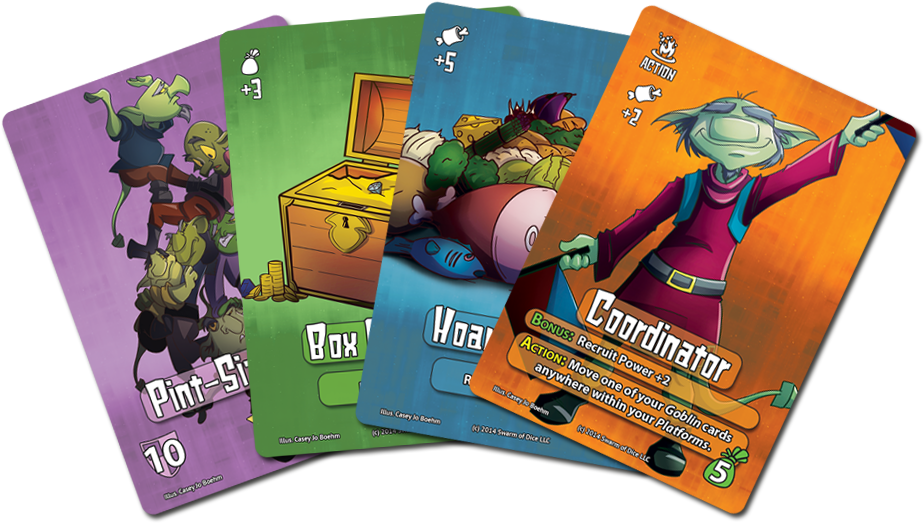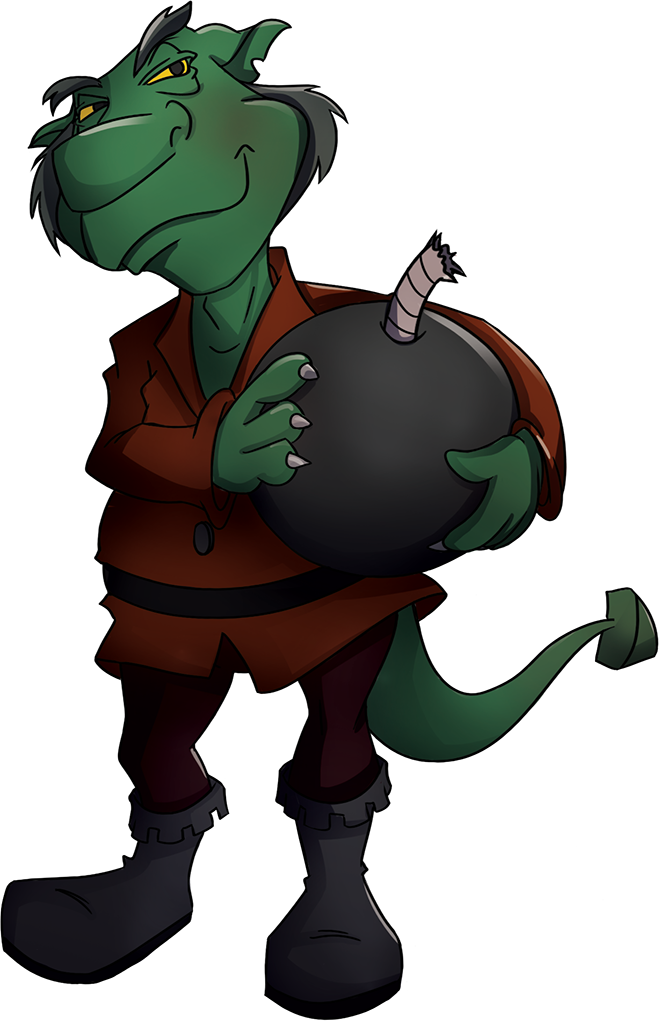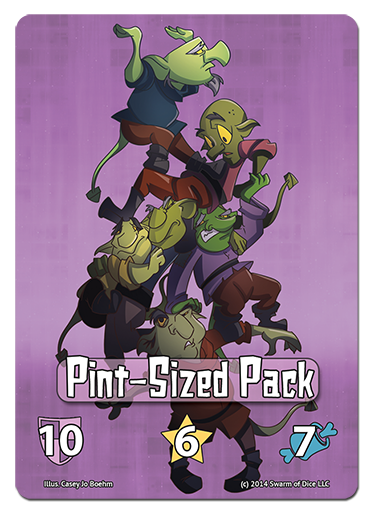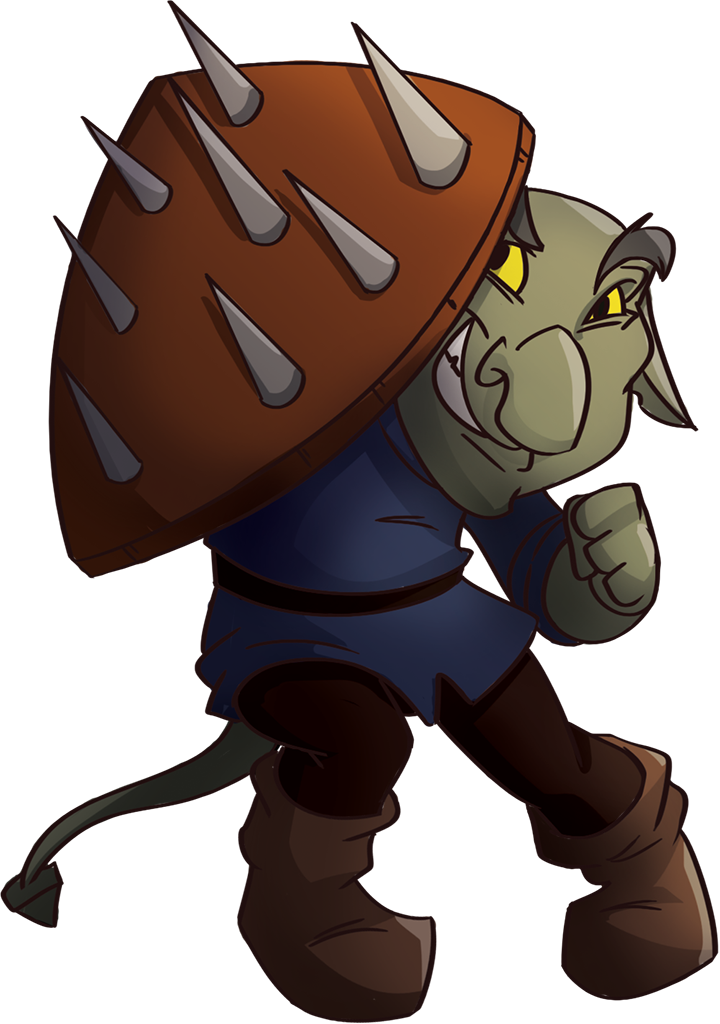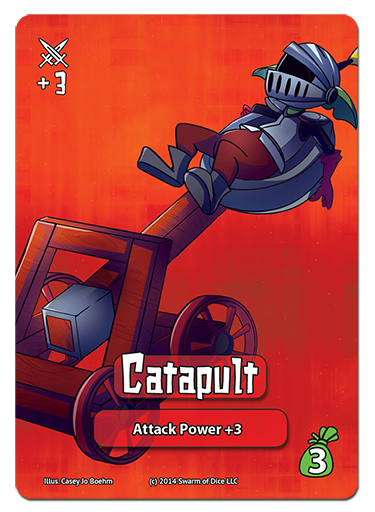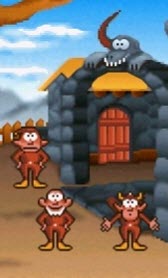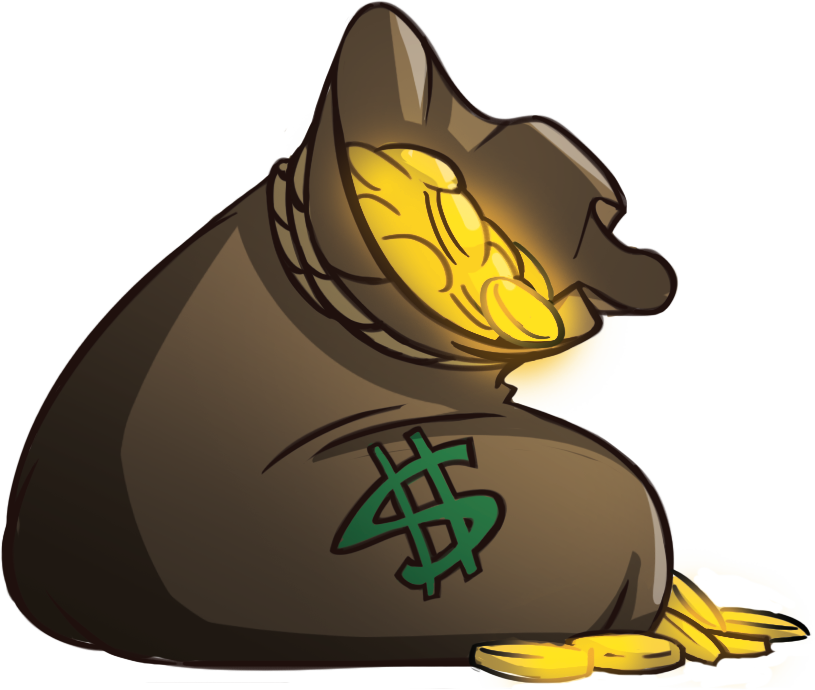Ruling a kingdom is never easy. We have experimented with all sorts of ways to govern throughout history, and over time, we figured out that some of them proved better than others.
Of course, none of us are Goblins.
In this Goblin kingdom, many things are done differently, and that includes the rite of succession. Some on come down down down to Goblin Town, as we figure out who gets to be new Goblin head honcho in Loot & Recruit!
The game of Loot & Recruit is for 2-5 players, with each player vying to get the most Goblins to their side to secure the throne. In typical Goblin fashion, this is done by conscripting Goblins into your camp while trying to destroy those that don’t. The game takes place over 14 rounds, which is controlled by an Event deck, and a new Event is revealed at the beginning of each round. Events mildly alter the conditions of the round, such as giving everyone extra resources.
In this slightly combative Deckbuilder, each player begins with their starting deck. On your turn, you use those cards to primarily purchase new ones and attack opponents. At the end of those 14 rounds, your aim is to hopefully still in enough of one piece to lay claim to the the vacating throne.
There are two areas players focus on in Loot & Recruit. The main area is the three rows where you purchase cards. The first of these is the Permanent Row, where you can attain intermediate versions of four of Loot & Recruit’s five card types: money, food, Attack, and Goblins. They aren’t the most powerful versions of their respective types, but they certainly still help get you the resources you need to become the next Goblin King or Queen or Emperor or whatever.
(We figure part of the perk of being the new goblin in charge is you can call yourself whatever you want. So have at it.)
With the exception of Goblins themselves, everything you buy in the game costs Loot. Loot is Goblin currency, and like most deckbuilers, any card purchased with Loot is added to your discard pile.
The second row is the Shop. Unlike the Permanent Row, the Shop Row continually changes. The game starts with five Shop cards revealed in a center row, and they are immediately replaced whenever a card is taken. (Think Ascension or Star Realms). Goblins like shiny things, and this is where the cool and shiny things show up, containing a randomized mix of more powerful Loot, food, and Attack cards, as well as hybrid cards.
The Shop also uniquely contains Action cards that do a variety of different effects when played, such as boosting your Attack power for the turn or trashing cards from your deck. Action cards are one of the primary ways Loot & Recruit creates the variety of deck styles. One player, for instance, could try to thin their deck as much as possible, while another may benefit from trying to stuff as many cool Attack cards into it as possible and become a legendary Goblin nuisance.
The third row is the Crowd. The Crowd Row functions identically to the Shop Row, with two exceptions. First, this is the main place where you acquire your Goblin entourage. All Goblins in the game are attained by paying for their…wait for it…Recruit costs. Recruit is the other main resource in the game, and it is mostly generated via food cards.
So, yes, Loot And Recruit is that aptly named.
Hey, it’s Goblins. They aren’t that quick on most things. They’re lucky to have a stable enough society to enable an established form of succession at all.
Secondly, Goblin cards are not added to your deck. It is here where the game adds its unique twist to the deckbuilding mold. Instead, Goblins are put into a player’s tableau, referred to as their Platform. Each player’s Platform has three columns, and whenever you acquire a new Goblin you assign to one of those columns on top of any Goblins already there.This plays well into the game’s premise of swaying as many Goblins to your side as possible to become the ruler while also underlining the fickle nature of Goblin loyalty.
The Platform areas are, naturally, the other place players must take notice of throughout the game. Beyond their Recruit cost, every Goblin has two values: VP and Defense. Because Goblin attention spans (and lifespans for that matter) are relatively short, they can’t be relied upon to stick around the entire game to be scored. Instead, Loot & Recruit does three instances of scoring after each third of the game. At those points, players add the total VP worth of their current Goblins to their previous totals, and at the end of the game the person with the most points wins.
This multiple scoring approach is seemingly unnecessary at first, but as the Goblin masses fluctuate, it proves to be a wise choice, as the segmented scoring helps keep the playing field closely contested right til the end. It provides those with a poor series of draws in one phase of the game the ability to make up lost ground and avoids the runaway leader tendency of some deckbuilders due to luck. By monitoring score totals and the values of Goblins on the table, players have direct control over how well everyone else fares throughout the game.
Of course, this is done by doing what Goblins do best: attacking each other with wild abandon.
During your turn, Attack (and some Action) cards generate your total Attack Power. Once per turn, you can unleash that attack upon any other Goblin on the field, and while, yes, you can bombard your own followers, it’s probably better to go after those who don’t want you to be the chief Goblin.
Attacking is simple: pick a Goblin to be the brunt of your assault. If your Attack Power meets or exceeds that Goblin’s Defense value, you blow’d them up good; that Goblin and any stacked on top of them are trashed. Thus, taking a Goblin near the top of a column would remove one or two, but if you take out the bottom of a pillar of Goblinites, the rest will topple to their doom. After all, Goblins aren’t that graceful, or agile…or smart…or…well you get the idea.
This adds a distinctive but strategic ‘take that’ aspect to Loot & Recruit, putting the power and responsibility of keeping one another in check into the hands of the players. Essentially, Loot & Recruit plays like Dominion – if Attack cards actually attacked your opponents. Attacking not only necessary in this game to balance scoring, but it’s actively encouraged. Luckily, the game’s goofy premise alleviates the sting of direct confrontation.
Indeed, the only caveat to Loot & Recruit is play time. While the free-for-all style of attacking is far more entertaining and engaging with a larger player size, and more players helps truly encapsulate the chaotic nature of the game’s theme, it can start to drag a little with a full table. The more players you add, the less realistic its listed 45 minute play time the game becomes.
When all of the Goblin votes are in, Loot & Recruit is a game with a zany premise about trying to swing as many Goblins to your side for as long as possible, while simultaneously undermining your opponents’ efforts to do the same. Loot & Recruit operates in similar enough territory to other deckbuilding games for players to have a grasp of its mechanics quickly while still differentiating itself enough to be worthwhile on its own. With every playthrough offering different cards to purchase, basic strategies can shift from game to game, providing decent gameplay variety each time you seek the throne. So if you have an extra Box O’Shinies that you’d like to use, this game is one piece of loot that may be worth checking out. Luckily, you can do so right now over at Kickstarter!
Photo Credits: Loot & Recruit cover and images by Swarm of Dice.

